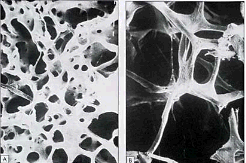Health Articles - Bone Density
OSTEOPOROSIS - - NOT JUST FOR WOMEN
One important and often overlooked preventative health measure is awareness of your bone health. Your bone mineral density (BMD) is the standard indicator for the degree of bone mineral found in your body. Loss or decrease in bone mineral density can lead to increased susceptibility for bone fractures, especially of the hip, spine, and wrist; however, any bone can be affected. Even though many women develop osteoporosis, especially after menopause, men are not immune from suffering the consequences of this disease.
Of the more than 10 million Americans estimated to have osteoporosis, 2 million are men, and there may be almost 34 million people who have a low bone density disorder called osteopenia. One in two white women will experience an osteoporotic bone fracture in her lifetime. Surprisingly, millions of Americans remain undiagnosed due, most likely, to the lack of symptoms. More often than not, the initial symptom is a fracture.
With the aging of society and longer life expectancies, the number of osteoporosis-related fractures could possibly increase. The economic burden of health care costs related to this disease is only surpassed by the potential pain and suffering of those afflicted. Advances in the science of diagnostic radiology coupled with public awareness afford us the opportunity to diagnose and treat this disease earlier and with greater efficiency.
The National Osteoporosis Foundation, American Medical Association, and other major medical organizations recommend a dual energy x-ray absorptiometry scan as the gold standard for diagnosing this disease. The DXA bone density scanner is known for its high level of accuracy and low dose of x-ray exposure. The radiologist uses the scan data to compare to the average score of a same sex adult, with normal bone density, to score your study.
Risk factors include, but are not limited to: female, Caucasian or Asian race, thin and small body frames, family history of osteoporosis, history of fractures as an adult, cigarette smoking, lack of exercise, and poor nutrition.
Prevention is key to addressing this problem . Early detection and treatment can substantially decrease your risk for fractures. While it is difficult to completely rebuild bone mineral, any bone loss you have suffered can be significantly improved with simple lifestyle changes. A baseline DXA bone density study is usually recommended by age 50 with follow-up exams every 3 - 5 years. Talk to your health care provider about this important diagnostic test and its inclusion in your health maintenance.

